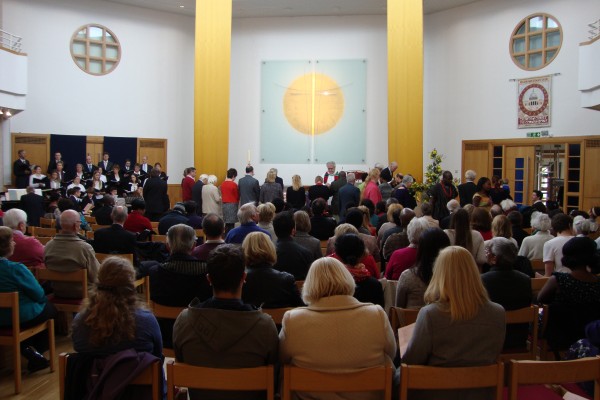Reflection on the Transfiguration Sunday, 14 February 2021
By Revd George Mwaura
Lord, as we bow in prayer, we ask that you reveal yourself in the ordinary places we inhabit
so we may behold your glory and receive the salvation wrought by your Son.
Amen
On 17 January this year, a team of climbers from Nepal became the first mountaineers successfully to complete a winter attempt on the summit of K2, the world’s second tallest peak. The group of Sherpas had paused at a point 70 metres short of their goal to wait for each other before climbing into the world’s history books together. Located on the Pakistan–China border, K2 is the only mountain over eight thousand metres that had not been summitted in winter. I am sure you watched all those images on your television sets. Their success was, however, marred by the death on the mountain of renowned Spanish climber Sergio, who fell down a crevasse as he attempted to make his way down to Base Camp.
Most of you will also perhaps remember that amazing story in 1953 when a New Zealand beekeeper named Edmund Hillary and a Sherpa guide, became the first ever human beings to reach the summit of Mt Everest. Here was a mountain that was unreachable, fearsome, and deadly; a mountain that had defeated fifteen previous expeditions. Some of the planet’s most experienced climbers had perished on its slopes. For many, Everest represented the last of the earth’s greatest challenges, the last frontier, so to speak. The North Pole had been reached in 1909; the South Pole in 1911, but Everest, often referred to as the Third Pole, had defied all human efforts. Reaching its summit seemed like a feat beyond mere mortals. But now, at last, success! And to crown their success; their arrival at the summit was announced on the morning of the coronation of Queen Elizabeth II: a truly mountaintop experience – literally.
It is heroic narratives like these that helped to coin the phrase mountaintop experience. The mountaintop experience which we encounter this morning in the Gospel of Mark has Jesus and his three closest disciples – Peter, James and John – going up on Mt Tabor. Mt Tabor, as those who have been to Israel will testify, is more of a hill than mountain, but that is beside the point. There was nothing unusual about Jesus going to such a place. He often went off from the crowds to pray and rest-ordinary stuff. After healing Simon Peter’s mother, the following morning, if you remember Ernesto’s sermon, Jesus withdrew to a quiet place to pray. That is how he fed his ministry. But from here onwards, nothing will be ordinary again in Jesus’ life.
No sooner do they arrive on top of this mountain than Jesus is suddenly transfigured: his clothes became dazzling white, whiter than anyone in the world could bleach them. Not only extraordinary, but out of this world, which, of course, is precisely what the story wants to convey. And as if that is not extraordinary by itself, two of Judaism’s most honoured sons suddenly appear. Moses the law giver and Elijah the prophet par excellence both show up representing the Law and the Prophets. This is both literally and figuratively a mountaintop experience. It is like a gathering of Who’s Who in the cosmic pecking order! No wonder the disciples are terrified. But a little terror never stopped Peter from running with his mouth and, for lack of any bright ideas, he suggests erecting three tents to commemorate the event!
This is mindboggling; but wait, it is not even over! Suddenly a cloud overshadows the mountain covering everything and the voice of God is heard crystal clear booming like JEJ: This is my Son, whom I love. Listen to him.
Wow, dazzling face and clothes, visits from famous figures of the past, hovering clouds, and heavenly voices; sounds like science fiction, doesn’t it? But it was not!
It was so extra ordinary that when it was all over, and the four of them were headed down the mountain, Jesus told them not to tell anyone about what they had seen. That kind of made sense to me, you know. Who would have believed them anyway?
But back they went, down the mountain into the real world. The mountaintop experience was wonderful, exceptional, and inspirational, but it came to an end because that is not where their calling was located.
That was true for Jesus and his disciples and it’s true for you and me. Back down the mountain we must go. Yes, we need to be inspired once in a while – or even twice in a while. But seeking religious thrills is not what Christian discipleship is all about. No mam, no sir! Our call is into the valleys and plains of the care homes and nursing homes, the schools and hospitals, the prisons and detentions centres, the churches and in the communities where we live, because that is where the needs are. That is where the people of God spend their ordinary lives.
Today is Racial Justice Sunday and as we mark this day, we remember that our place is not at the top of the mountain hobnobbing with those who oppose and oppress God’s children because of the colour of their skin, religion, or nationality. No, no! Our place is in the valleys and plains. On the streets with those demonstrating under the banners of BLM, #Me too, and other worthy courses that seek to free those for whom justice has been delayed and denied. In Christ Jesus, to paraphrase the Apostle Paul, there is no colour or gender. We are all one. We are all children of the same God.
Oddly enough, that incredible mountaintop experience at Mount Everest 68 years ago ended in a remarkably similar way to the story of the transfiguration. After Edmund Hillary had climbed Mount Everest, he was knighted by the Queen and became a household name round the world. Think Jessica Ennis Hill, Dame Kelly Homes, David Beckham, or Lewis Hamilton; that kind of fame. He became a spokesperson for Roebuck and his name appeared on many sporting goods. He could have lived for the rest of his life in his little tent on top of his Mt of success if he chose to, but he did not. Instead, he went back to Nepal, back to the Sherpas, whom he had grown to respect and love. Without them he would never have been able to conquer the mountain. In his book years later, Hillary recounted how an elderly Sherpa from the village of Khumjung, where most of the crew for his Everest climb came from, had come to him a few years after that expedition and said to him: Our children lack education. They are not prepared for the future. What we need more than anything is a school. So, Hillary founded the Himalayan Trust, and in 1961 a three-room schoolhouse was built with funds raised by the tireless mountaineer. To date the trust has built over thirty schools, two hospitals and fourteen medical clinics, plus numerous bridges, and airfields. In recent years, the trust has expanded its scope, devoting considerable funds to rebuilding Buddhist monasteries and to reforesting the valleys and slopes in the region.
Sir Edmund Hillary had his mountaintop experience and it moved him to a life of mission. And that is as it should be with all of us. Yes, we need mountaintop experiences, and the view from up there is incredible as well as inspirational. But we are never intended to stay up there. Peter never built his tents on Mt Tabor, Moses and Elijah went back to heaven. And Jesus; well, Jesus went back to where the people were, back to the valleys and plains to preach, to teach, to heal, and eventually to Jerusalem, to the last supper, to his betrayal, trial, the cross, death, resurrection, and salvation.
From mountaintop to mission: Yes, the mountain tops are wonderful and it’s where our batteries are recharged, and we gain inspiration. But we need to remember that our mission is in the valleys, the plains and meadows where the suffering people of God reside. That is where you will find Christ. That is where we must be. Let us meet there, shall we?
Amen


